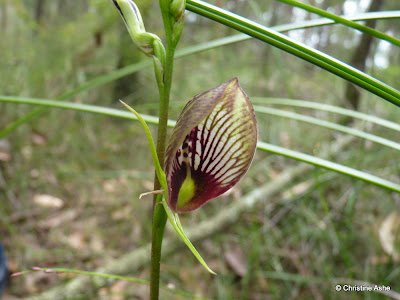I mentioned in a previous post how exciting it was to discover new plants on our acreage and I have another two orchids to tell you about. It is very satisfying to walk in our natural bush and discover more and more things are managing to spring back into life now that the hard hooved animals have been removed, ie horses, goats and donkeys. It was fun having horses in our lives for a few years but that time has been and gone. As our teenage girls have grown up and are producing offspring of their own it is feasible that the time may come again. Never say never.
The first of the orchids is Cryptostylis subulata, also called Large Tongue Orchid or Cow Orchid. Large Tongue orchid I can appreciate but where did the name Cow Orchid come from?
The next photograph shows the Cows' Head. See the long front face and the ears and horns? Imaginative eh?
Plants are about 30 to 50cm high, these were closer to the 30cm mark. They have long narrow leaves. Some bright green ones can be seen in the background of the above photo. Many flowers are stacked one above the other on a long stalk and open over a period of a few weeks - there can be up to 10 flowers per stem . Above you can see a finished flower to the left and buds above the open flower still to come.
Check out below how hard they are to spot in the bush. Yep you could walk right past and not even see them. Part of their charm once you know they are there I think.
Last look at Cryptostylis subulata
.
The other orchid was spotted on the same walk and is quite similar. In fact it took me quite a few photographs before I realised there were two distinct types of orchid. Hard to believe when you see them here that they could look alike in the bush but you will have to take my word for it.
Introducing Cryptostylis erecta. Ta ta da dah.
Same many brown flowers on one stem, same height of plant, same 1 to 3 lanceolate leaves popping out of the ground, same location in the bush - open clearing. The difference is the "Cow's tongue" is open this time. The brown colouration seemed the same in the bush but looks quite different here in the photographs.
Can you appreciate the name erecta? The expanded part of the labellum, the stripey inflated bit above, forms a kind of erect hood or bonnet. In C. subulata there is a distinct downward droop, quite different to these guys. I'm ashamed that I couldn't see straight away how different they were, although in my defence the two people I went walking with couldn't see it even when I pointed it out to them.
Cute don't you think? There are 20 species of Cryptostylis in the world with only 4 being endemic to Australia and I have now spotted two of them. Yay me. I'll be keeping a sharp eye out for the other one which is found here on the Central Coast.
Our Australian species are even more special because they are fertilised by ichneumon wasps. The plants rather cunningly send out pheronomes which attract the male wasps who think they are copulating with a female wasp, and thus spread pollen from one plant to the next.
Who would have believed that plants could be so sneaky? It is also a reminder that everything is interconnected. If we destroy the habitat of one part of the flora or fauna world we have no idea of the follow on consequences from our act.















